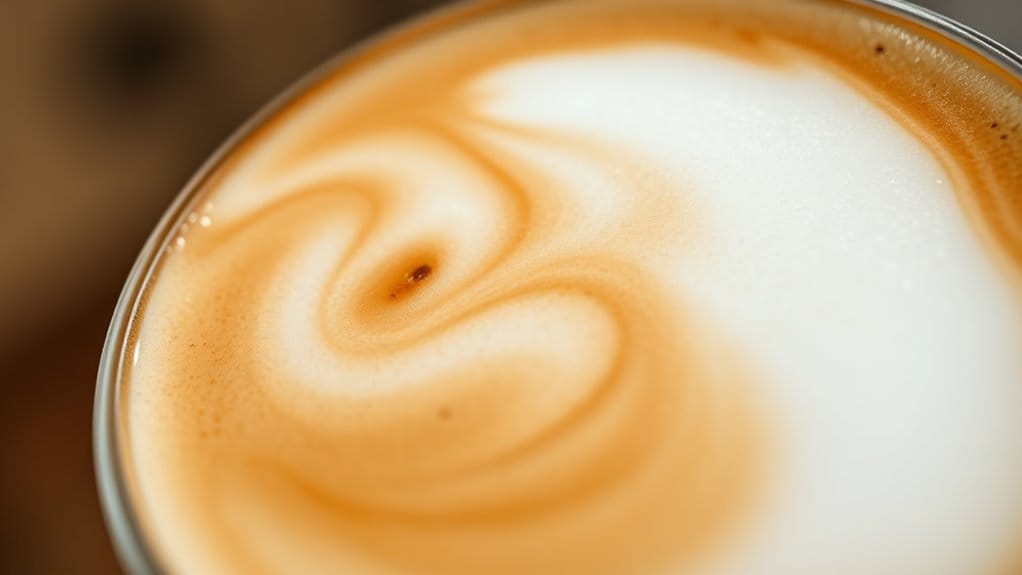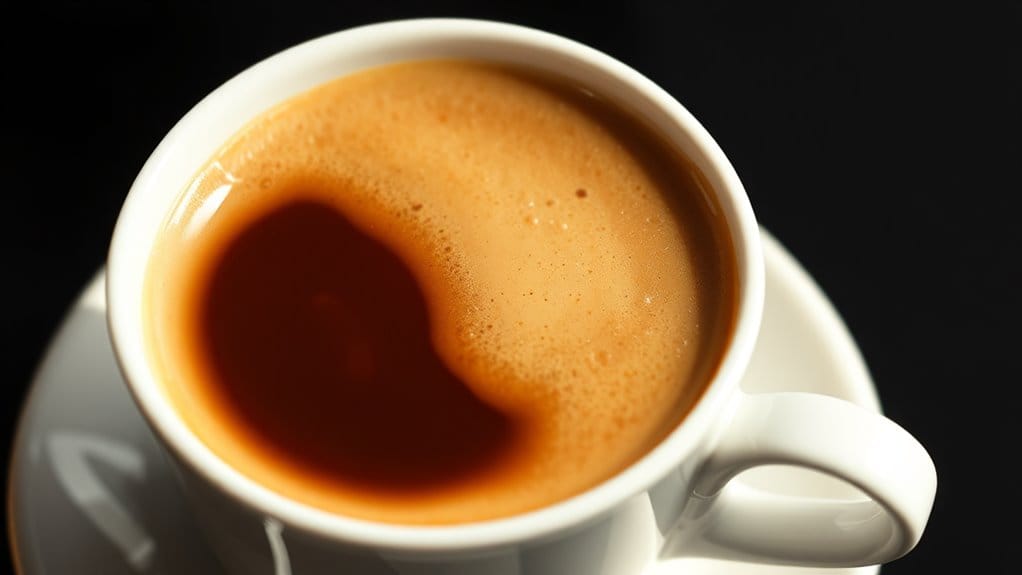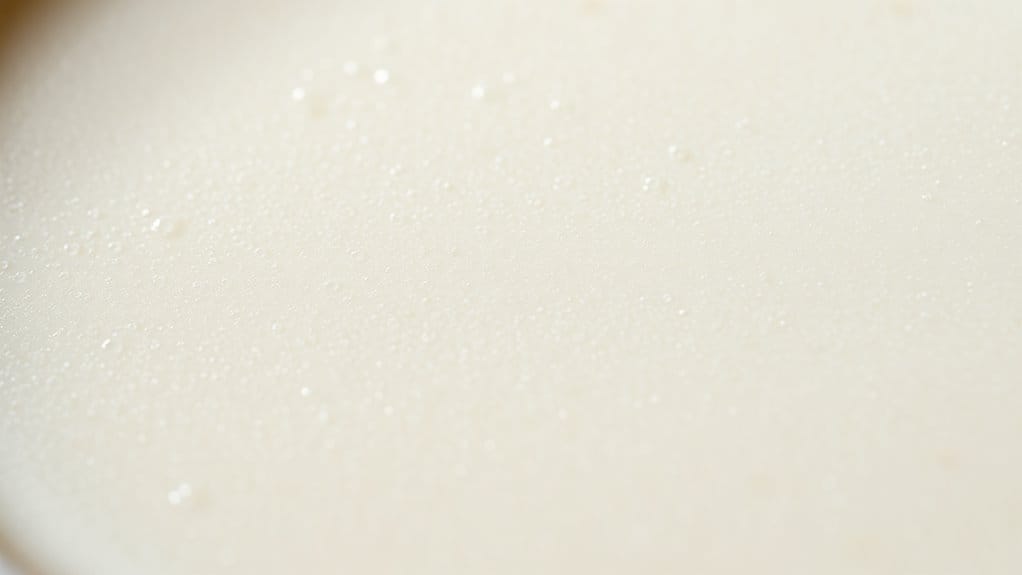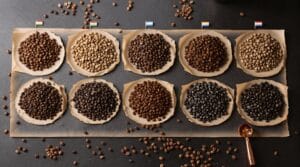A cafe latte’s sweetness comes from its ingredients and prep: milk sugars like lactose, coconut’s fructose, or soy’s caramel notes mix with espresso’s caramelized flavors. Using the right milk-to-coffee ratio (lots of milk, less bitter coffee), proper steaming (heated just enough to reveal sweetness, not burn it), and balanced espresso strength (not too bitter or sour) all play a role. Details like milk type, technique, or roasts can turn a latte into a sweet sip—dig deeper for the tasty secrets.
The Role of Milk Type and Natural Sugars

As far as latte sweetness is concerned, the type of milk used is a game-changer, as different milks bring their own natural sugars to the party!
Coconut milk, for example, sneaks in tropical vibes with glucose and fructose, blending creamy texture and nutty sweetness that makes lattes taste like dessert. Local coffee roasters often recommend flavors that complement these milks, enhancing the overall experience with complex flavors.
Soy milk swings by with sucrose—think vanilla and caramel hints—plus frothy magic that dances with espresso. The perfect cortado cup size ensures that the espresso-to-milk ratio is optimized for flavor.
Whole milk, the classic choice, leans on lactose for mild sweetness, its fats and proteins smoothing coffee’s bite like a cozy blanket.
Even almond and oat milk join the fun, some flaunting beta-glucans or added sugars for milky-sweet vibes.
Achieving the perfect latte also hinges on milk’s optimal temperature, with 140°F (60°C) being the sweet spot to enhance natural sugars while creating a lush, frothy texture.
Whether a cafe latte is sweet or a caffe latte leans subtle hinges on these sugars, fats, and how they party in your cup.
A latte’s balance of sweetness or subtlety lies in milk sugars and fats, dancing together in your cup.
Skip the sugar, let the milk shine!
Impact of Espresso Strength and Milk Ratio

Milk isn’t the only player in a latte’s sweetness—the espresso and how much milk gets poured in matter just as much! This is why a latte’s higher milk ratio outshines a cappuccino in natural sweetness, as the latter’s thick foam mutes sugar release. Balancing bitter and sweet is a dance between coffee strength and creamy dilution. Here’s how they team up:
- Espresso’s fingerprints: Too strong (over-extracted), and bitterness smothers sweetness; too weak (under-extracted), and sourness steals the spotlight. A 1:2 espresso-to-water ratio hits that buttery, caramel-like sweet spot. Espresso machines have revolutionized consistent extraction that plays a crucial role in achieving this balance. The use of coarse ground coffee also significantly impacts the extraction process for optimal flavor.
- Milk math magic: More milk means more natural sugar to soften espresso’s bite. A 1:3 espresso-to-milk ratio creates a smooth, sweet hug for your taste buds. The process of brewing is vital, requiring precision in grind size and temperature for optimal results.
- Strength vs. sweetness showdown: Bold espresso needs extra milk to stay sweet, but go too light on coffee, and the drink becomes a milky puddle.
- Shot counting: Two shots amp up bitterness, drowning milk’s sweetness—stick with one to keep harmony.
Steaming Techniques and Temperature Influence

Steaming milk perfectly can turn a latte from “meh” to magical, with temperature being the secret sauce for sweetness!
The sweet spot? Aim for 140–165°F (60–74°C), but stick to 150–155°F (65–68°C) for max flavor-boosting magic.
Too cold, milk feels thin and shy, like it forgot its lines.
Too hot (above 160°F), it burns the sugars, turns bitter, and sulks in your cup.
Heat reveals milk’s natural sugars—lactose—like a hidden treasure, while proteins and fats team up for velvety texture.
Start steaming: inject air early for microfoam, tilt the pitcher gently to swirl that milk into a creamy whirlpool! Using a controlled vortex technique with tools like the NanoFoamer ensures consistent microfoam by evenly distributing tiny air bubbles.
A digital thermometer keeps things honest, and patience prevents overheating.
Happy steamed milk is sweet, silky, and ready to hug your espresso.
Frequently Asked Questions
Do Flavored Syrups Affect a Cafe Latte’S Sweetness?
Flavored syrups increase sweetness through added sugars and flavor compounds that intensify sweetness perception. They mask espresso bitterness via molecular interactions, while their aromatic and textural qualities elevate subjective sweet notes without altering actual sugar content.
How Does Coffee Bean Roast Level Influence a Latte’S Sweetness?
Roast levels orchestrate sweetness like caffeine-fueled dancers: light roasts flaunt unburnt sugars, medium croon caramel anthems, dark rebels scorch sweetness for smoky bravado. Acidity, Maillard reactions, and milk chemistry conduct the symphony on taste buds.
Can Cold Lattes Taste Sweeter Than Hot Ones?
Cold lattes can taste sweeter than hot ones due to reduced espresso bitterness, increased milk lactose perception, and frequent syrup additions. Temperature influences texture and aroma, with cold drinks often muting harshness and amplifying sweetness contrasts.
Why Add Toppings Like Whipped Cream to Lattes for Sweetness?
Whipped cream introduces subtle sweetness through its fat content and sugar integration, enhancing the latte’s flavor balance while adding velvety texture. Its customizable nature accommodates varied preferences for indulgence without reliance on syrups.
Does Honey or Agave Syrup Alter a Latte’S Sweetness Differently Than Sugar?
Honey and agave syrup contain fructose, which is sweeter than sucrose (sugar), consequently requiring smaller quantities to achieve equivalent sweetness. Their distinct flavors—floral or rich—also modify taste beyond sweetness compared to sugar’s neutral profile.





